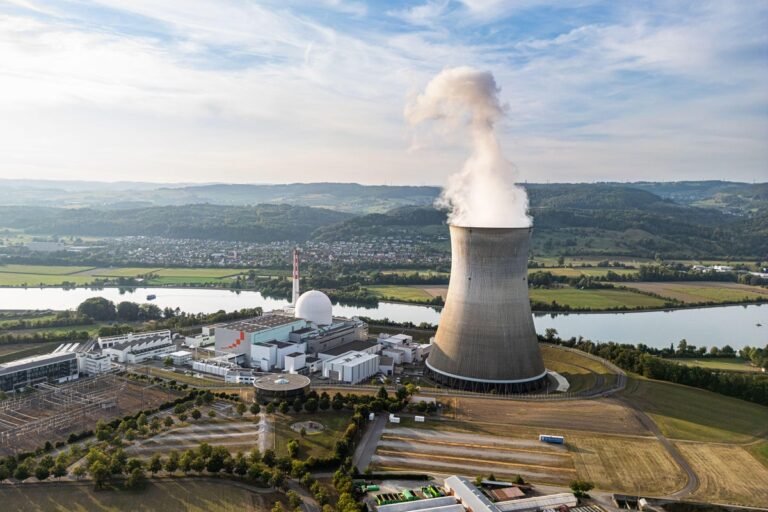Miniature Neutrino Detector Promises to Test the Laws of Physics
A relatively small detector caught neutrinos from a nuclear reactor using a technique known as coherent scattering
A nuclear power plant in Liebstadt, Switzerland, hosted the CONUS+ neutrino detector.
Andreas Haas/dieBildmanufaktur/Alamy
Physicists have caught neutrinos from a nuclear reactor using a device weighing just a few kilograms, orders of magnitude less massive than standard neutrino detectors. The technique opens new ways to stress-test the known laws of physics and to detect the copious neutrinos produced in the hearts of collapsing stars.
“They finally did it,” says Kate Scholberg, a physicist at Duke University in Durham, North Carolina. “And they have very beautiful result.” The experiment, called CONUS+, is described on 30 July in Nature.
Challenging quarry
On supporting science journalism
If you’re enjoying this article, consider supporting our award-winning journalism by subscribing. By purchasing a subscription you are helping to ensure the future of impactful stories about the discoveries and ideas shaping our world today.
Neutrinos are elementary particles that have no electrical charge and generally don’t interact with other matter, making them extraordinarily difficult to detect. Most neutrino experiments catch these elusive particles by observing flashes of light that are generated when a neutrino collides with an electron, proton or neutron. These collisions occur extremely infrequently, so such detectors typically have masses of tonnes or thousands of tonnes to provide enough target material to gather neutrinos in relevant numbers.
Scholberg and her collaborators first demonstrated the mini-detector technique in 2017, using it to catch neutrinos produced by an accelerator at Oak Ridge National Laboratory in Tennessee. The Oak Ridge particles have slightly higher energies than those made in reactors. As a result, detecting reactor neutrinos was even more challenging, she says. But lower-energy neutrinos also allow for a more precise test of the standard model of physics.
Scholberg’s COHERENT detector was the first to exploit a phenomenon called coherent scattering, in which a neutrino ‘scatters’ off an entire atomic nucleus rather than the atom’s constituent particles.
Coherent scattering uses the fact that particles of matter can act as waves — and the lower the particles’ energy, the longer their wavelength, says Christian Buck, a leader of the CONUS collaboration. If the wavelength of a neutrino is similar to the nucleus’s diameter, “then the neutrino sees the nucleus as one thing. It doesn’t see the internal structure”, says Buck, who is a physicist at the Max Planck Institute for Nuclear Physics in Heidelberg, Germany. The neutrino doesn’t interact with any subatomic particles, but does cause the nucleus to recoil — depositing a tiny amount of energy into the detector.
Catching sight of a nucleus
Coherent scattering occurs more than 100 times as frequently as the interactions used in other detectors, where the neutrino ‘sees’ a nucleus as a collection of smaller particles with empty space in between. This higher efficiency means that detectors can be smaller and still spot a similar number of particles in the same time frame. “Now you can afford to build detectors on the kilogram scale,” Buck says.
The downside is that the neutrinos deposit much less energy at the nucleus. The recoil induced on a nucleus by a neutrino is comparable to that produced on a ship by a ping-pong ball, Buck says — and has until recent years has been extremely challenging to measure.
The CONUS detector is made of four modules of pure germanium, each weighing 1 kilogram. It operated at a nuclear reactor in Germany from 2018 until that reactor was shut down in 2022. The team then moved the detector, upgraded to CONUS+, to the Leibstadt nuclear power plant in Switzerland. From the new location, the team now reports having seen around 395 collision events in 119 days of operation — consistent with the predictions of the standard model of particle physics.
After COHERENT’s landmark 2017 result, which was obtained with detectors made of caesium iodide, Scholberg’s team repeated the feat with detectors made of argon and of germanium. Separately, last year, two experiments originally designed to hunt for dark matter reported seeing hints of low-energy coherent scattering of neutrinos produced by the Sun. Scholberg says that the standard model makes very clean predictions of the rate of coherent scattering and how it changes with different types of atomic nucleus, making it crucial to compare results from as many detecting materials as possible. And if the technique’s sensitivity improves further, coherent scattering could help to push forward the state of the art of solar science.
Researchers say that coherent scattering will probably not completely replace any existing technologies for detecting neutrinos. But it can spot all three known types of neutrino (and their corresponding antiparticles) down to low energies, whereas some other techniques can capture only one type. This ability means it could complement massive detectors that aim to pick up neutrinos at higher energies, such as the Hyper-Kamiokande observatory now under construction in Japan.
This article is reproduced with permission and was first published on July 30 2025.
